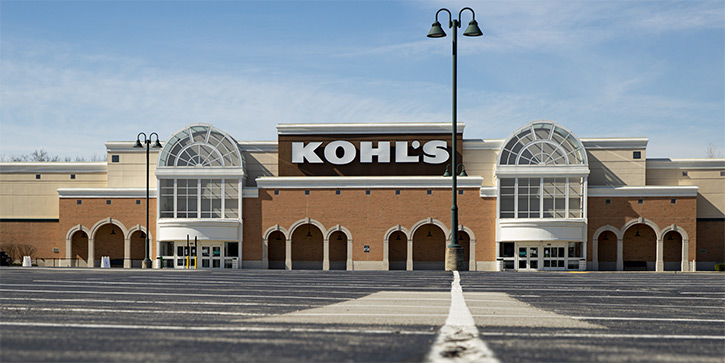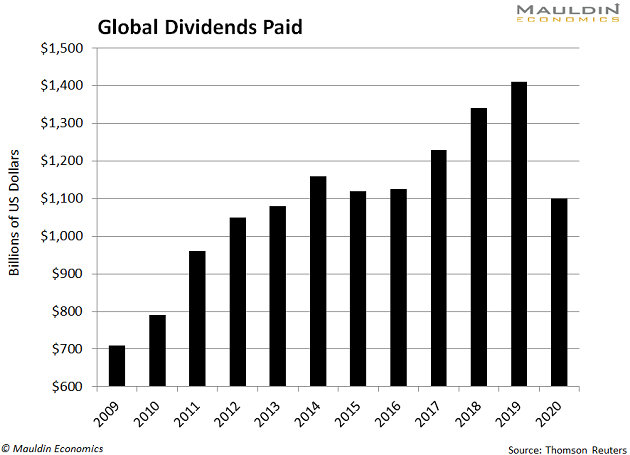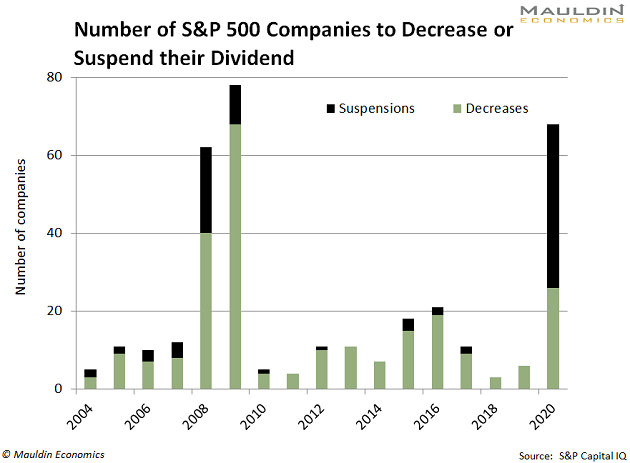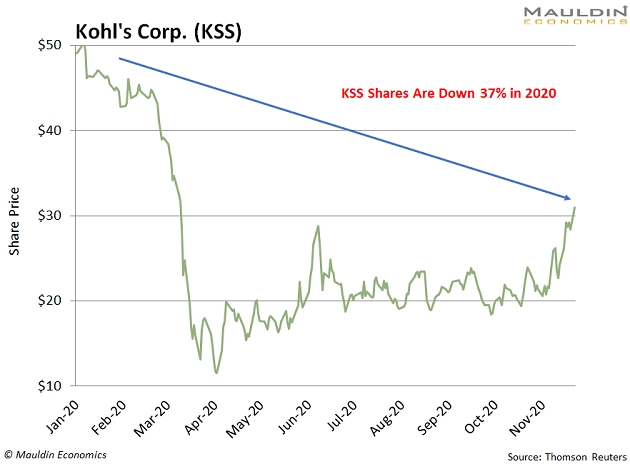
Don’t Buy These Back-from-the-Dead Dividend Stocks
- Robert Ross
- |
- The Weekly Profit
- |
- November 25, 2020
“I really need to cut back on my spending.”
A friend of mine told me this back in March. As an actor in Los Angeles, his work screeched to a halt during the COVID-19 lockdown.
Today, 63% of creative workers and artists are still fully unemployed. The Americans for the Arts puts the average loss per worker at $22,000 this year.
- This translates into $50.6 billion in lost income in 2020… just for this sector.
My friend is happy he saved what he could, when he could. But it wasn’t just struggling actors who slashed their spending.
Everyone from Mom-and-Pop shops to Fortune 500 firms found ways to cut their spending and raise cash for a still-to-be-determined number of rainy days as this pandemic drags on.
One of the most common ways large publicly traded businesses found some "instant money" was by reducing or altogether eliminating their dividends.
- In total, global companies cut their dividends by 22% in 2020:

Some 27% of dividend-paying companies cut their dividends this year.
- That makes 2020 the worst year for dividend investors since the global financial crisis.
We stayed on top of these dividend cuts throughout the crisis. From cruise ships to casinos, we steered away from companies whose payouts my Dividend Sustainability Index (DSI) identified as being in danger.
This year is the worst in a decade for dividends. But now we’re seeing many of these companies reinstate their dividends.
- Should you buy these reminted dividend payers? Probably not.
Paying dividends shows investors how strong your business is. After a company pays all its expenses and reinvests in the business, the best ones use leftover cash to reward their shareholders.
A steady—and rising—dividend payout is a good sign of a company's health. It is a vote of confidence about its own near-term future.
Most companies are not required to pay a dividend, but they do have to pay their bills. So when a company cuts its dividend, it's not a bad idea to take that as a potential warning sign about its financial health.
In 2020, 68 companies in the S&P 500 either decreased or suspended their dividends. So, it’s safe to say even large US businesses were struggling:

Now some of this year's dividend cutters are getting ready to bring their payouts back.
These Industries Are Coming Back from the Brink
Thanks to late-stage vaccine candidates from Pfizer (PFE), AstraZeneca (AZN), and Moderna (MRNA), industries that got crushed by COVID-19 are seeing light at the end of this very long tunnel.
For example, take retailer Kohl’s (KSS). The company was one of 42 S&P 500 companies to eliminate its dividend this year. But after sales fell less than expected, CFO Jill Timm pledged to resume the dividend in 2021.

Apparel chain Gap (GPS) followed suit. While the company was missing rent payments only a few months ago, its CEO pledged to resume the payout in 2021.
Discount retailer TJX Companies (TJX) also said it would return some of its $10.6 billion in cash to shareholders starting next year.
Major energy companies are getting in on the action. Marathon Oil (MRO) stopped its payments in May. But after repositioning, the company has declared a dividend payment for December.
Lastly, the beleaguered restaurant industry is also showing signs of life. Darden Restaurants (DRI)—which operates Olive Garden, LongHorn Steakhouse, and other chains—also plans to serve up dividends again.
I'm glad that these companies are coming back to the dividend table.
But I'll keep avoiding them like the... well… plague.
I Like Companies That Don’t Cut Their Dividends
Only real estate investment trusts, business development companies, and the like are required to pay their stakeholders.
Maybe it's just me, but I put dividend cutters on par with bad business partners. Why trust a company that cut its dividend once not to do it again?
It’s one of the main reasons my Dividend Sustainability Index (DSI) looks at how many years a dividend has been paid. The model leans on that safety metric because it works.
For instance, every stock in the Yield Shark portfolio must meet a certain threshold on the DSI. The model includes everything from the number of years the dividend has been increased to debt levels in order to assess if a dividend is safe.
You know how many companies in the Yield Shark portfolio saw their dividends cut in 2020?
Zero.
- In fact, every company in the Yield Shark portfolio RAISED its dividends in 2020.
And that’s during the worst year for dividends in a decade.
So if you're tempted to buy into these companies whose dividends couldn’t handle a few quarters of weak sales, don’t be surprised when—not if—they get cut during the next crisis.

Robert Ross

